Chapter 4: Kom Ombo and the Temple of of Horus at Edfu

Kom Ombo
Dec 4, 2003
As we set sail down the Nile from Aswan our first stop was Kom Ombo or the city of gold. As you can imagine snakes and crocodiles are not the friends of farmers who make their living by taking water out of the river. But both have been tamed - I hope....
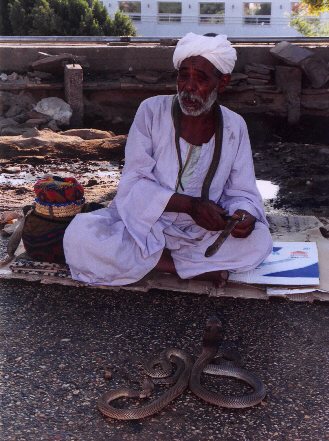 |
I'll have to admit that I am not partial to cobras and seeing this snake charmer as we headed for the temple at Kom Ombro was a shock. In fact, our tour guide gave me a snake to hold before I saw the above scene. But the Crocodile man and I have one survival skill in common -- when you hold a snake you hold it tightly. |
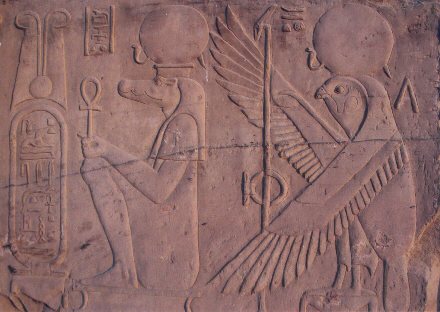
The temple at Kom Ombo is unique in that it is dedicated to two deities, Sobek, the crocodile god, and Horus the falcon god. In this temple Sobek is identified as Seth (remember he killed Osiris), the enemy of Horus. The people dedicated half of this temple to Sobek believing they would be spared by these reptiles. So, half the temple is dedicated to the good guy (Horus), but, hedging their bets, the other half is dedicated to the bad guy (Sobek) seeking to be left alone.
![]()

Dec 5, 2003
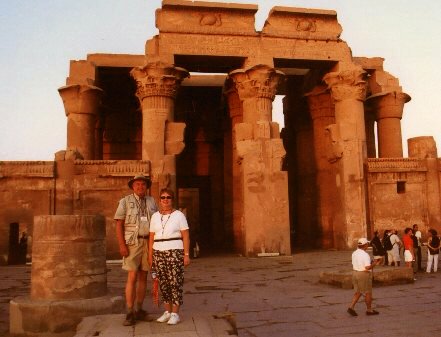 |
The twin Temples at Kom Ombo were dedicated too two deities, Horus and Sobek, and it was natural and fitting that there be two, and equal, entrances. |
| Note the carvings above the portal in the above photo. We see the cobra surrounding the sun, the symbol Ra, and the outstretched wings which are a symbol of protection. So all who entered here were protected. More importantly you see just a hint of color in that portion of the gate which was protected against the sun and rain. | 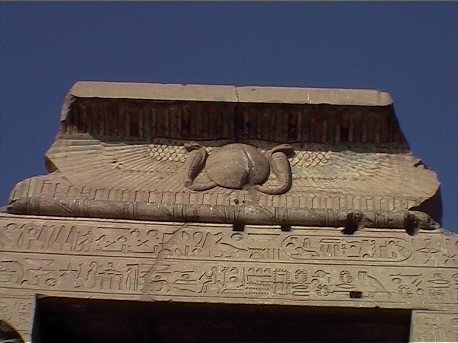 |

Dec 5, 2003
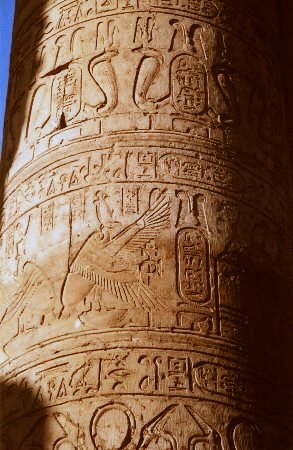 Even if the symbols on the columns and pillars and walls were not actually a written language and the temples had no religious or historical significance the art work is just amazing. |
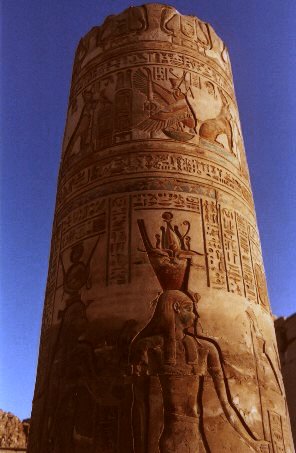 And beautiful. Here is one side of a column which has retained most of its original color. Can you imagine what the entire temple must have looked like at one time? We were at the temple as the sun was setting so there was a nice warm yellow glow on all the sandstone buildings and columns. |

Dec 5, 2003
An Egyptian Art Lesson
Lets see what you can learn about this relief carved on a wall in Kom Ombo.
The body was always displayed in the following way: Lower torso below waist always shown in profile. From waist to neck it was always a frontal view to show the chest, however, in order to depict women one breast is always shown in profile. Hands and arms are always shown in profile. The head was always shown in profile. Everyone always had something on their heads to designate what they were. A goddess (left) would carry a UADJ scepter which was a lotus flower. A god (right) would carry a UAS. Note in these reliefs the figures have belly buttons. This is a feature of the late Kingdom. If you looked at their feet (always in profile) you would note that in this period people would also be depicted wearing sandals.
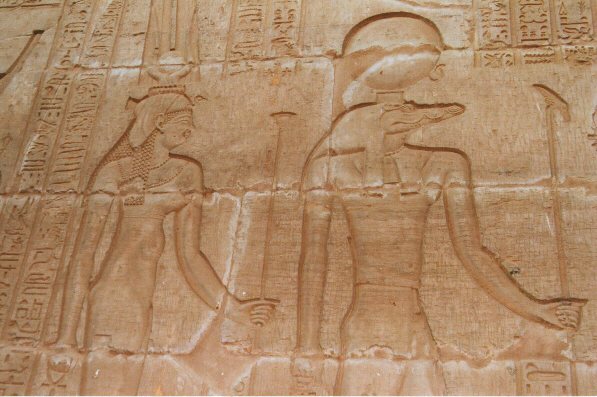
These are common things you will see in the artwork. Look for it in some of the other pictures I send out. It helps identify who is who and what is what and sometimes you are surprised.
![]()

Dec 9, 2003
As we returned to our river boat after visiting Kom Ombro we saw this guy going home with a crate of eggs.
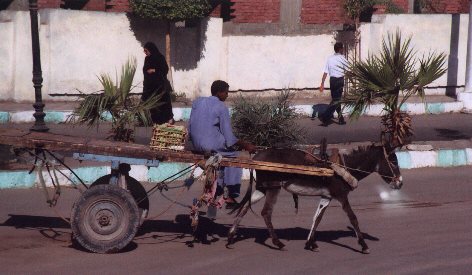
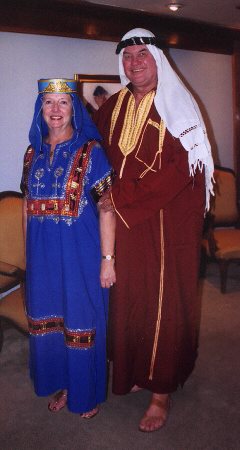 |
If you have read my web page and followed my efforts to find out "Why Women Wear Hats in Peru" you know how hard I try to fit in with the local population in order to get some good "character" photos. One night I was invited to a party for other used camel salesmen so we put on our best clothing and attended the event. Here I am wearing the traditional Galabeya and head scarf. Wouldn't you buy a used camel from this couple? |
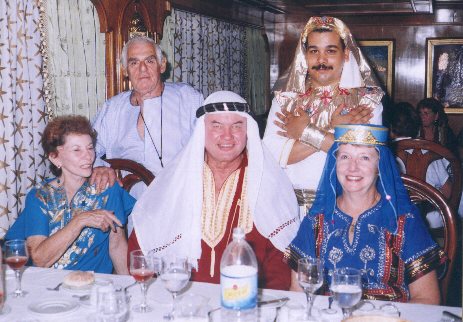
The red drink you see in our glasses is a sweet nectar called Karkadeh made from boiling hibiscus petals in water. Muslims do not drink alcoholic beverages and this wonderful nectar was served at all social occasion. The party lasted way into the night.
![]()

Dec 9, 2003
Edfu
I can't exactly explain it but my favorite god was Horus. Maybe it was because he had the best image and stood for good and was always fighting against evil. I liked how he was protrayed, a falcon head wearing the crown of Upper and Lower Egypt. So, as you can imagine, after a night of socializing with the rest of the camel herders I was excited to wake up in Edfu which has the temple to Horus.
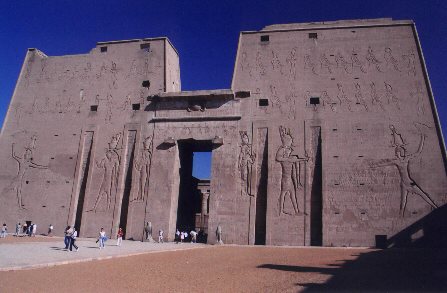
Here are the pylons to the temple of Horus. You can't mistake Horus carved on either side of the gate with the Pharaoh offering gifts.
| Naturally I didn't throw away the opportunity to have my picture take with Horus guarding the gates. It is just amazing how large these statues were. And remember, they are carved out of black granite which had to be shipped down the Nile from Aswan. Check out my Maps of Egypt to see how far this is. It would have been no easy task carving granite with bronze age tools. | 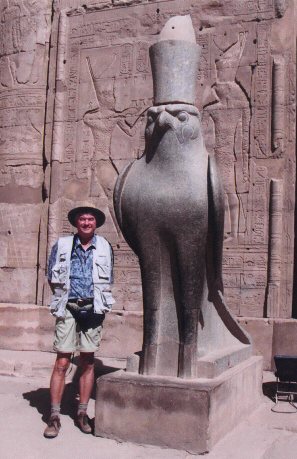 There is no truth to the suggestion that I liked Horus because our legs look alike. |
![]()

Dec 10, 2003
Here we see a depiction of our hero Horus capturing Seth and offering him to Osiris. Isis stands behind Horus to observe the event. Unfortunately the relief was damaged by Christians who objected to showing images of heathen gods.The second photo shows a close-up of Seth, depicted as a Hippopotomus, in total submission with his legs in chains.
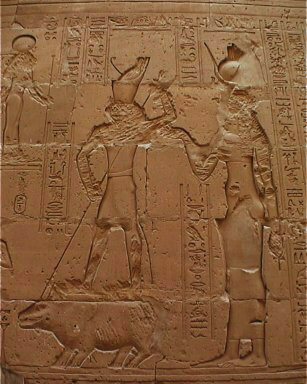 |
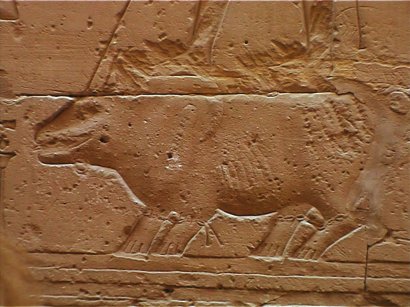 |
![]()

Dec 10, 2003
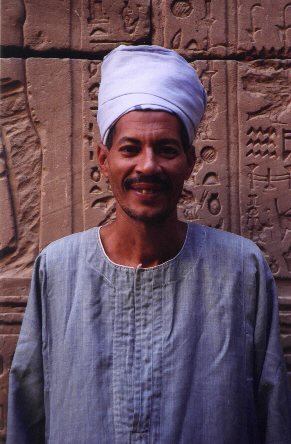 My dentist would love Egypt. LOL But, after the photo was taken the guy - never any women seen in these places - would say, "How about something for me?" and hold out his hand. I generally had a stack of one pound notes in my pocket and would gladly give him one. ($.16) If it was a particularly good shot I might shell out five pounds ($1.00) When you went to the bathroom there was always an attendant standing at the door with a roll of toilet paper in his hand. He would pull off about 6" of paper and hand it to you to do with what you will. This generally was worth 25 piasters ($.05). But, since it was not uncommon to have no Egyptian coins they would frequently get a one pound note. At one time Egypt was divided into two separate Kingdoms. The Pharaoh of the Lower Nile (south of Luxor) was depicted as wearing a white crown that looked like a bowling pin. The Pharaoh of the Upper Nile (north of Luxor) would be shown as wearing a red crown that looked like chair with a feather. When the two kingdoms were united theh Pharaoh would be shown as wearing the double crown a symbool of the united kings.
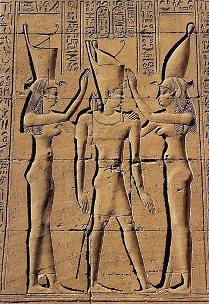 In the temple at Edfu there is a depiction of this event. The goddesses the Lower Nile (right) and Upper Nile (left), each wearing the crown of their respective kingdoms, are crowning the Pharaoh with the new combined crown. Looking at the crown which a pharaoh is wearing gives us an idea of the time frame when the relief was carved and who the pharaoh is. So much is shown in these pictures. We left Edfu and the temple of Horus behind us about noon and again went Cruising Down the Nile.
Jump StationGo to The Egyption Museum of Cairo - Under ConstrucionGo to The Religious Faiths - Under Construction Go to Street Scenes of Cairo - Under Construction Go to Who are the Gods? - Under Construction. Go to Chapter 9: The Khan el-Khali Bazaar - Under Construction Go to Chapter 8: The Pyramids - Under Construction Go to Chapter 7: East Thebes and the Temple of Luxor - Under Construction Return to Chapter 6: The Pyramids.Return to Chapter 5: Karnak Temple at Luxor and the Temple of Hathor at Dendera. >Return to Chapter 4: Kom Ombo, Edfu, Karnak and Dendera. Return to Chapter 3: Cruising Down the Nile. Return to Chapter 2: Abu Simbel and Aswan. Return to Chapter 1: Introduction to Egypt. Read about my version of The Gods of Egypt and Diagram of Temples. Return to Belli's Home Page
For more information about our travels write to

|